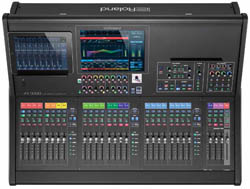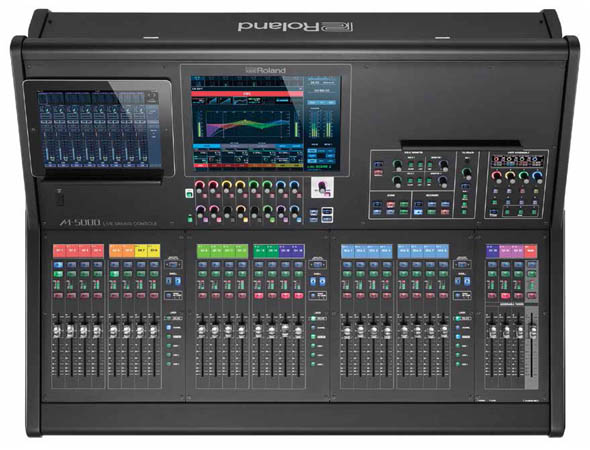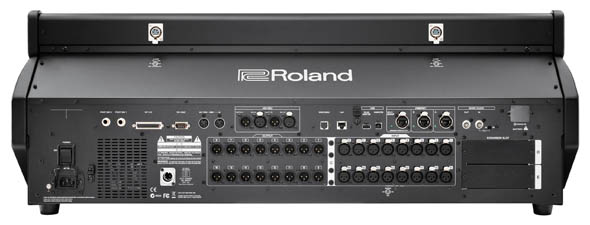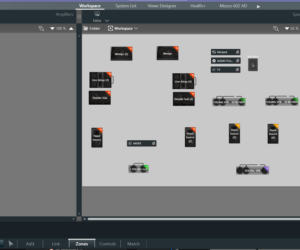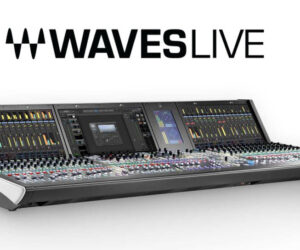Roland Pro AV has unveiled the M-5000, a new larger format live mixing that’s the first to incorporate the company’s O.H.R.C.A. technology platform.
O.H.R.C.A. (short for “Open High Resolution Configurable Architecture”) is expressly designed to conform to the needs of both the application and the operator by delivering freely definable audio paths, flexible user interface and workflow, expandable protocols, and multi-format I/O choices, all at 96 kHz sound quality.
——————————————————
Go here for Mark Frink’s exclusive “first look” at the new M-5000.
——————————————————
As a result, the new M-5000’s internal architecture is not fixed and can be freely defined to allow the operator to essentially “build” a console structure to suit the needs of the application. The free assignable audio paths can be used for mixing channels, auxs, matrices, subgroup buses, mix-minus buses, and other input/output configurations within a range of up to 128.
O.H.R.C.A enables the console to be flexible enough to accommodate a diverse array of uses. A primary application is for the monitor position where a high number of auxiliary buses are needed. At the same time it is equality at home being defined for a FOH position in touring, live music, theaters, broadcasting and more.
In addition to two REAC ports, the M-5000 has two expansion card slots to support a diverse range of system configurations and audio transport protocols such as Dante, MADI, Waves SoundGrid, more REAC ports, as well as future formats and functions.
The back panel includes 16 x 16 analog I/O, 4 x 4 AES/EBU, a 16 x 16 USB audio interface, connection for control via an iPad connected or wireless, and control ports including foot switches, GP I/O, RS-232C and MIDI. All of this capability enables the console to see up to 300 inputs and 296 outputs, all at 96 kHz and even more at 48 kHz.
Further, the patching ability allows and input to be patched directly to one or more outputs without having to use up a mixing channel – ideal for comms, tielines, click track, etc.
The M-5000’s flexible workflow allows users to adapt preferences to individual needs. A 12-inch color touch screen, 28 channel faders in four groups, multifunction knobs and buttons, “touch and turn” functions, plus a user assignable section makes mixing fast and accurate.
The channel and user-assignment displays utilize bright, full-color organic technology for high visibility in any light. A user-assignable section comprised of four encoders and eight buttons in three banks provides quick access to key functions.
The M-5000 comes with remote control software (Mac/Windows) designed to fully operate the console, which extends the user interface and windows beyond the built-in GUI. The application allows individual windows to be separated out and resized resulting in a completely flexible organization of critical pages or meters on external monitors.
96 kHz audio with exceptional mic preamps built into the console, as well as Roland’s extensive digital snake lineup, helps ensure high quality sound from end to end. A single mixing channel can have three assigned inputs: primary, backup for instant swap, and one for playback/record. Each channel also includes 4-band PEQs, two dynamics processors that can be pre or post EQ, delay, and more.
The M-5000 includes eight stereo multieffect processors with an array of powerful effects, including classic vintage Roland effects as well as classic Boss compact pedal effects. 32, 31-band graphic EQs (or 8-band parametric EQs) can be used simultaneously and are not part of the effects processor allocation. Mains support for 5.1, LCR, LR, plus surround panning and stereo downmix are also available in the mixer configuration.
The family of the Roland Pro Audio products such as digital snakes, personal mixers and recording/playback all work seamlessly with the new platform. This allows an M-5000 console to work with any of the thousands of systems already running worldwide.
In addition, the full lineup of peripherals have always supported 24-bit/96kH operation, resulting in an instantaneous and automatic doubling of sampling frequency simply by replacing a Roland M-400 or M-480 with a M-5000, for example.
Integrating an M-48 personal mixing solution is particularly powerful for hybrid monitor positions. A hybrid solution is where the front-line, more mobile talent’s monitor mix is off the console buses in the traditional way, while other musicians such as drummer, keys, orchestra may be on M-48 personal mixers.
With the powered REAC port on the M-5000, an M-48 can be placed on the console itself and whenever the monitor engineer selects a musician in the list displayed on the screen, the M-48 will instantly mirror itself to that position. Connecting that M-48’s line outs to one of the monitor buses enables the engineer to flip back and forth between musicians on aux buses and musicians on personal mixers.
The R-1000 48-channel player/recorder rounds out the family of devices that are fully integrated with its ability to playback or record up to 48 channels.
Go here for Mark Frink’s exclusive “first look” at the new M-5000, with further specifics also available here.


